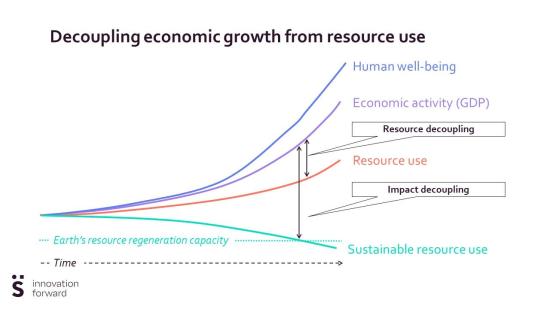Measuring is knowing, but knowing alone does not appear to be enough: global circularity has been steadily declining, year after year, since 2019. Just as important as knowing measurement results is accepting that we need to make adjustments if we want to have an impact on those results. Some tips about this alternative view and approach.
We know that our earth is finite and, as a consequence, we need to disconnect our material consumption from economic growth. The message is: not grow a little slower in material consumption, but reduce consumption below the carrying capacity of our only planet. This is not an ideology, these are known facts.
Scale and engagement of measurements
'The Circularity Gap Report 2023' gives an unmistakable message: global circularity dropped from 9.1 per cent in 2018 to 8.6 per cent in 2020 to 7.2 per cent in 2023. Measuring is knowing, but knowing alone does not appear to be enough.
At the corporate level, we see the same trend. Suppose data analysis indicates that your materials consumption and environmental impact are increasing with increasing production and sales. Almost everyone in your company will probably say - or think - that they already knew that. So you know that things will get worse and worse for the environment if you keep going at this rate. Have you come to the same conclusion in your company?
What do we do with this knowledge? The key lies in answering the question of who 'we' are: the government, companies ... everyone seems to be waiting for everyone else.
Why wait? The reasoning we often hear from business leaders, project managers in charge of circular projects, policymakers ... usually goes as follows:
-
There is no market demand yet, let alone willingness to pay for circular products and services.
-
The offer of circular products and services does not meet my needs.
-
There is no support yet for this necessary change.
-
We have to wait for the regulations to be put in place so that we, as a company, are not penalised for the extra cost that circular products and services entail.
-
Companies are not eager for new regulations. Perhaps it makes more sense to hit the pause button.
Each of these arguments is based on real observations. On the other hand, they are also somewhat contradictory when take a closer look.
In short, there is a need for a different perspective, a different way of facing the challenge.
New perspective based on the belief that you matter
The lack of commitment to such measurements does not immediately encourage to take concrete action. It is important that you really believe that you can contribute to change, that you can have an impact on the situation. You may not yet know how, but you are determined that it is possible, even necessary. So there is more than just measuring and knowing: your willingness to take action and modify your behaviour is, if possible, even more important.
This paragraph is explicitly about you, about the human being behind the role you have in your company. Everyone has doubts, can be anxious or unsure, once we are ready to face reality. On the other hand, people are very resilient, innovative and, above all, we have the gift of cooperation. This should give us confidence that together we will come up with and work out solutions, step by step.
Changing the perspective from 'focus on the challenges' to 'focus on the opportunities' not only gives more energy, but also leads to new insights and renewed momentum. A focus on innovation (not necessarily technological), aimed at circular strategies such as product life extension, allows us to gradually see more opportunities, which make sense to explore further.
Translate this belief into a big enough challenge
Set the bar high! Making the level of ambition high enough makes it more attractive to pursue. A proposal for improvement by 5 or 10 per cent is good, but not very attractive. Doubling or improving by a factor 10 does require a different approach and mindset, which definitely generates more creative tension between what is here now, our deep belief in what is necessary, and our ambition to contribute to alleviate this need.
That this also involves some emotional tension (fear, stress, anger, sadness, anxiety, disbelief ...) is not necessarily a negative thing. Acknowledging it is important. By telling the truth about both the creative tension and the emotional tension, a real picture emerges. A reality that is not just a dream, but a challenge we want to take on. Gradually, the focus will shift to ‘What do we want to create ourselves?’. That is exactly what you want the organisation to focus on.
(Source: Genwise)
Practice at manufacturing companies
Our experience with manufacturing companies is that actions will only be attractive and feasible if we look at them from other perspectives: circular, regenerative, triple P, from value chain and product life cycle thinking ... More in particular, by looking for a win for the company, the customer, other stakeholders and for society.
An example of a circular strategy focused on remanufacturing. This is what win-win can look like:
-
Profit for the company: Better/stronger customer relations (recurring business), often high profit margins, access to data and insight into why products are discarded, information on the status of the product when discarded, remanufacturing fits as additional revenue models (product as a service, renting, spare parts harvesting...), creation of local jobs close to the user of the product, ...
-
Profit for the customer: Lower costs, shorter lead time, spare parts availability, additional value from services such as upgrades, monitoring, ...
-
Gain for society and stakeholders: Lower material consumption, lower carbon footprint, possible offerings for specific customer segments, skilled jobs for problem-solving profiles
What we see that is working in manufacturing companies: By taking small steps, you and your team gain more and more confidence. This gradually increases the extent to which you see and experience the impact, and consequently the extent to which you can really make a difference. It is a typically empowering dynamic that we see at pioneering companies.
Key role
An additional insight that deserves extra attention is that companies that play a leading role as market leaders, key innovators, trendsetters ... also have a key role in this transition. These companies have the R&D capability, the market impact, the leverage to also pull the cart in a circular way. What do you think about frontrunners who do nothing? Use that great influence on market, product and service development to help drive the vision and level of ambition. The currently small innovators may soon break through. Think of Tesla's position a decade ago, and then what the EV market division looks like today. On top of that, the pressure on the established companies is increasing due to the rapid introduction of European regulations. The time is now.
Does your company also want to be a part of the solution? Be sure to let us know! There are many ways to put your money where your mouth is. Contact us and we will guide you to the format that best suits your company: learning networks, individual projects, matchmaking, collective projects, masterclasses ...






